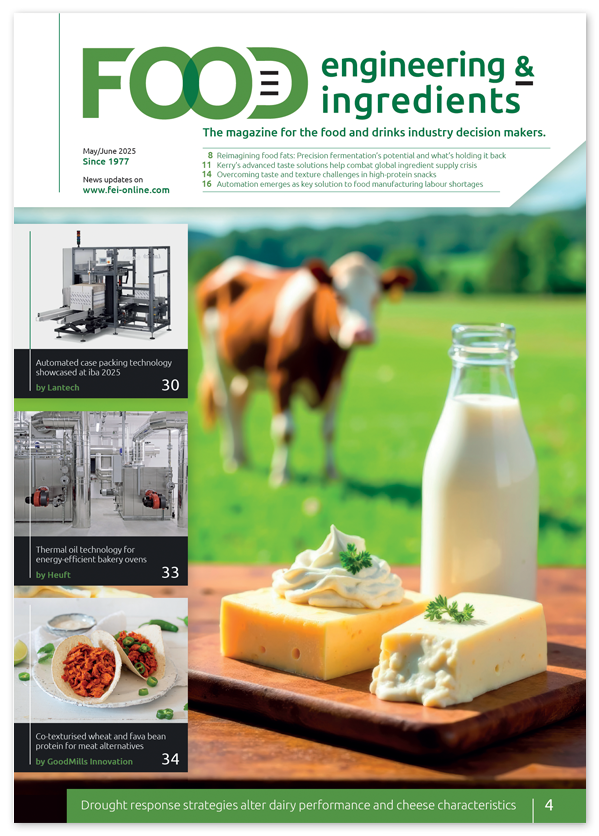Sports nutrition beverages and the Olympic effect
Fredrik Hjelmqvist looks at sports nutrition beverages, market evolution and the everyday athlete in the lead up to Paris 2024.

Fredrik Hjelmqvist, vice president Beverages & More at dsm-firmenich
Every four years (excepting the delay during the pandemic years) the world tunes in to watch sportspeople at the top of their game compete for glory at the Olympics. This celebration of sporting excellence pours billions of dollars into the economy of the host nation, in a phenomenon dubbed ‘The Olympic Effect’. While the economic significance of the games is fascinating, this article is concerned with a different type of ‘Olympic effect’, that on consumers, their participation in sporting activities and subsequent demand for sports nutrition products.
Since the very first academic studies focused on the impact of the games, researchers have observed spikes in ‘ordinary’ people taking up sports, particularly within the host countries. In the two years following the London 2012 Olympics for example, the number of adults participating in sporting activity (defined as three occasions a week for 30 minutes) rose by over a million every quarter.[i] Millions more everyday athletes first and foremost means happier and healthier populations but it can also translate into an increase in sales of sporting goods and equipment, and an enlarged consumer base interested in foods and beverages designed to keep them at the top of their game.
Versatile, convenient and already closely associated with exercise performance and recovery, beverages are especially well-placed to satisfy the sports-conscious consumer. Indeed, figures from Euromonitor are already predicting a significant uplift in energy drink market growth in line with the start of Paris 2024.[ii] With the next Olympiad just around the corner, what better time to evaluate how the sports beverage market can evolve to meet the current wave of new everyday athletes, whether they are seasoned gym-goers or newly inspired by the spirit of the Olympic games. Jog along as we explore the trends, ingredients and formulation techniques brands can harness to craft winning beverages, fit for those moved by this year’s Olympic Effect, and beyond.
The starting blocks: Understanding the priorities of today’s sports beverage consumer
With benefits including improved hydration, energy, mobility, maintained or increased muscle mass, faster recovery, immunity and better sleep quality, more consumers are adding specialized sports nutrition to their diets. And drinks are an increasingly popular format for their ease of consumption, variety in flavours, and often multifaceted health benefits.
While hydration,[iii] energy and relaxation[iv] often top consumers’ priorities when it comes to a sports drink, the market has matured in recent years. Beverages aimed specifically at providing energy enhancement developed a ‘bad’ reputation as sugar- and caffeine-laden quick fixes where the crash outweighs the lift[v] but this has paved the way for a more natural approach to energy drinks – one that centres on a controlled energy release.
Meanwhile, more than 70% of consumers in a recent Global Data survey[vi] called gut and immune support ‘the most appealing functional beverage benefits’, while Mintel found that almost a third of energy drink consumers would be motivated to buy a product proven to promote brain health.[vii] This leads to functional beverage fans being highly engaged with both on-pack claims and ingredient lists. Consumers want to see specific vitamin and mineral content listed on labels. In fact, just under half of the drinks consumed by survey respondents in early 2023 contained vitamins and minerals, while 52% stated they checked product packaging for their inclusion before buying.[viii]
Critically, consumers now also expect health driven assurances like ‘low sugar’, ‘sugar-free’ and – increasingly – ‘natural’.[ix] Research from dsm-firmenich found that well over three quarters of beverage consumers wanted to know whether a product contained natural or artificial colorants, with non-synthetic options securing significantly higher purchase intent.[x] Standards around sugar content in beverages are tightening too. As an example, The European Soft Drinks association, UNESDA, extended its 2025 sugar reduction targets by a further 10%,[xi] following a review of their initial goals, and many other global authorities have similarly amped-up their sugar reduction targets to support public health.
Such trends mean there’s a long list of priorities that manufacturers will need to balance to create a functional sports beverage which appeals to the widening consumer base as the ‘Olympic effect’ kicks off.
First leg: Addressing trends of colours and flavours
Even in the sports beverage sector where drinks are nominally expected to be ‘functional-first’, flavour and texture often matter more than health claims.[xii] However, the colours and flavours in sports nutrition have evolved in recent years, gone are the bright greens and blues with manufactured, synthetic tastes like blue raspberry. Now sports and energy drinks lean towards nature-inspired sensory experiences like peach and citrus flavours with low sugar profiles that still deliver on a refreshing, clean flavour.
Manufacturers’ secret weapon in natural but vibrant colours are β-Carotenes – a family of carotenoid pigments. These nature identical pigments offer the sector great potential, providing naturally vibrant red, orange and yellow hues. Plant-based and fermented sweetening solutions are also valuable, imparting a delicate sweetness without any added sugar, and with the additional benefit of increased fibre content in some cases.
The main stretch: Delivering functional properties
For elite and amateur athletes, a sports beverage which aids muscle building and faster recovery will always be a top priority. The king of all the macronutrients here is protein and athletes should prioritize protein sources that contain all nine essential amino acids, even better if they are high in branched chain amino acids like leucine.[xiii]
There are many different protein sources that meet these needs but with more people proactively trying to add more protein to their diets – a good variety in sources is recommended both for nutritional and experiential diversity. For example, dsm-firmenich’s PeptoPro® is an advanced peptide formulation derived from dairy proteins and containing all 20 amino that support muscle protein synthesis and is virtually lactose and fat free. The uniquely small molecules in PeptoPro® make for easy digestibility and quick absorption for near-instant delivery to muscles.
Meanwhile, Vertis™ CanolaPRO® protein isolate is another example of a protein “made” for sports nutrition. Sustainably extracted from canola (also known as rapeseed) press cake, it contains sufficient levels of all nine of the essential amino acids needed for an ingredient to be classed as a “complete protein”, reflected in its Protein Digestibility Corrected Amino Acid Score (PDCAAS) of 1 – equivalent to that of animal protein. The solution is also rich in cysteine, an amino acid which may help protect against exercise-induced muscle damage as it is a building block for glutathione, making ideal for endurance athletes such as cyclists and long-distance runners. Vertis™ CanolaPRO® is also unique in that it is free from all major allergens, opening the potential for effective sports nutrition for all.
Final sprint: Balancing formulation for success
The biggest challenge in sports nutrition formulation is often balancing a high protein content against delivering a delicious texture and flavour, in a format that’s convenient for athletes and ordinary consumers alike. Many plant-based proteins for instance can impart undesirable vegetal taste profile that makes a chocolate-flavoured protein shake more chore than treat. In bar snacks too, a very high protein content can lead to a dry, chalky texture if not properly offset by the right texturizers.
At dsm-firmenich, we harness our full solutions portfolio to combine first-class functionality with textures and flavours sure to make winning products. Take our Vertis™ CanolaPRO® high-protein RTD chocolate-flavoured beverage concept for instance; here we combined our canola protein isolate with the texturizing properties of our GELLANEER™ gellan gum to create a smooth, creamy drink that packs a real protein punch.
When it comes to vitamins and minerals, we also take a holistic approach, looking at how all the different nutrients interact and staying on top of consumer trends for what’s trending in the functional drinks space. Minerals are relatively easy to incorporate into beverage formulations, but vitamins tend to be more sensitive to interactions with other ingredients, making them more challenging to manage. This is especially true for fat-soluble vitamins that require additional stabilization to enable inclusion in water-based beverages. This is why our Quali® vitamins were designed with solubility in mind, ensuring they blend seamlessly with any base beverage recipe by remaining clear and stable. For example, our spray-dried Vitamin E ingredient is easily dispersed even in cold water and is crystal clear in final applications. And where ingredient science isn’t able to make completely neutral-tasting nutrients – such as certain bitter botanicals or green tasting plant proteins – taste masking and natural flavour modulators can be employed to transform the purely functional into a fruity, floral, sweet or spicy moment to savour.
Looking to energy-focused drinks, caffeine and B vitamins remain the front runners. But at the other end of the spectrum is the increased popularity of mood and mind supporting beverages that offer a moment of calm in the middle of hectic training schedules. For mood support, there are simply too many functional ingredients trending at any given time to name but right now, adaptogens like ashwagandha and reishi mushroom are extremely popular, as are potentially calming botanicals such as lemon balm and chamomile.[xiv] Again, how these elements are incorporated is as important as what ingredients to include.
The finish line: Finding the ideal ingredients partner
To capture the everyday athlete’s attention, especially in the run up to the Olympics and to stand out in the increasingly competitive energy drinks space, brands need to create products that inspire and reflect the Olympic spirit in a beverage. To do this, brands will require more than just a supplier – they need a strategic partner. The most experienced players operating in food and beverage ingredients today offer concept development support, formulation expertise, regulatory and marketing advice and efficiency improvements, as well as a comprehensive portfolio of science-backed solutions. Fully supported by an advanced scientific portfolio of colourful solutions in taste, texture and health, at dsm-firmenich, we strive to be this ‘one-stop-shop’ for our customers, helping them work smarter at speed to create the next energy drink sensation that will truly stand-out during the ‘Olympic effect’.
About the Author
Fredrik Hjelmqvist is vice president Beverages & More at dsm-firmenich
www.dsm-firmenich.com
References
[i] KOKOLAKAKIS, Themis, LERA LOPEZ, Fernando and RAMCHANDANI, Girish (2018). Did London 2012 deliver a sports participation legacy? Sport Management Review.
[ii] Euromonitor, False Start? Assessing the Impact of Paris 2024 on Beverages, 13 December 2023, https://www.euromonitor.com/article/false-start-assessing-the-impact-of-paris-2024-on-beverages
[iii] Mintel, Functional Drinks Report US, 2023
[iv] Mintel, Functional Drinks Report US, 2023
[v] Ibid, Ghozayel et al, Energy drinks consumption and perceptions among University Students in Beirut, Lebanon
[vi] GlobalData, 2021 Q2 global consumer survey
[vii] A year of innovation in sports and energy drinks, Mintel 2020
[viii] Mintel, Functional Drinks Report US, 2023
[ix] Future Market Insights, Soft drinks industry’s sugar reduction commitments across Europe, September 2022, https://www.futuremarketinsights.com/reports/energy-drinks-market
[x] Global coloration study, dsm-firmenich 2021
[xi]UNESDA, Soft drinks industry’s sugar reduction commitments across Europe, https://www.unesda.eu/sugar-and-calorie-reduction/#:~:text=UNESDA%20has%20committed%20to%20reduce,milk%20based%20and%20hot%20beverages
[xii] Mintel, Functional Drinks Report US, 2023
[xiii] Jäger, R., Kerksick, C.M., Campbell, B.I. et al. International Society of Sports Nutrition Position Stand: protein and exercise. J Int Soc Sports Nutr 14, 20 (2017). https://doi.org/10.1186/s12970-017-0177-8
[xiv] Mintel, Functional Drinks Report US, 2023


